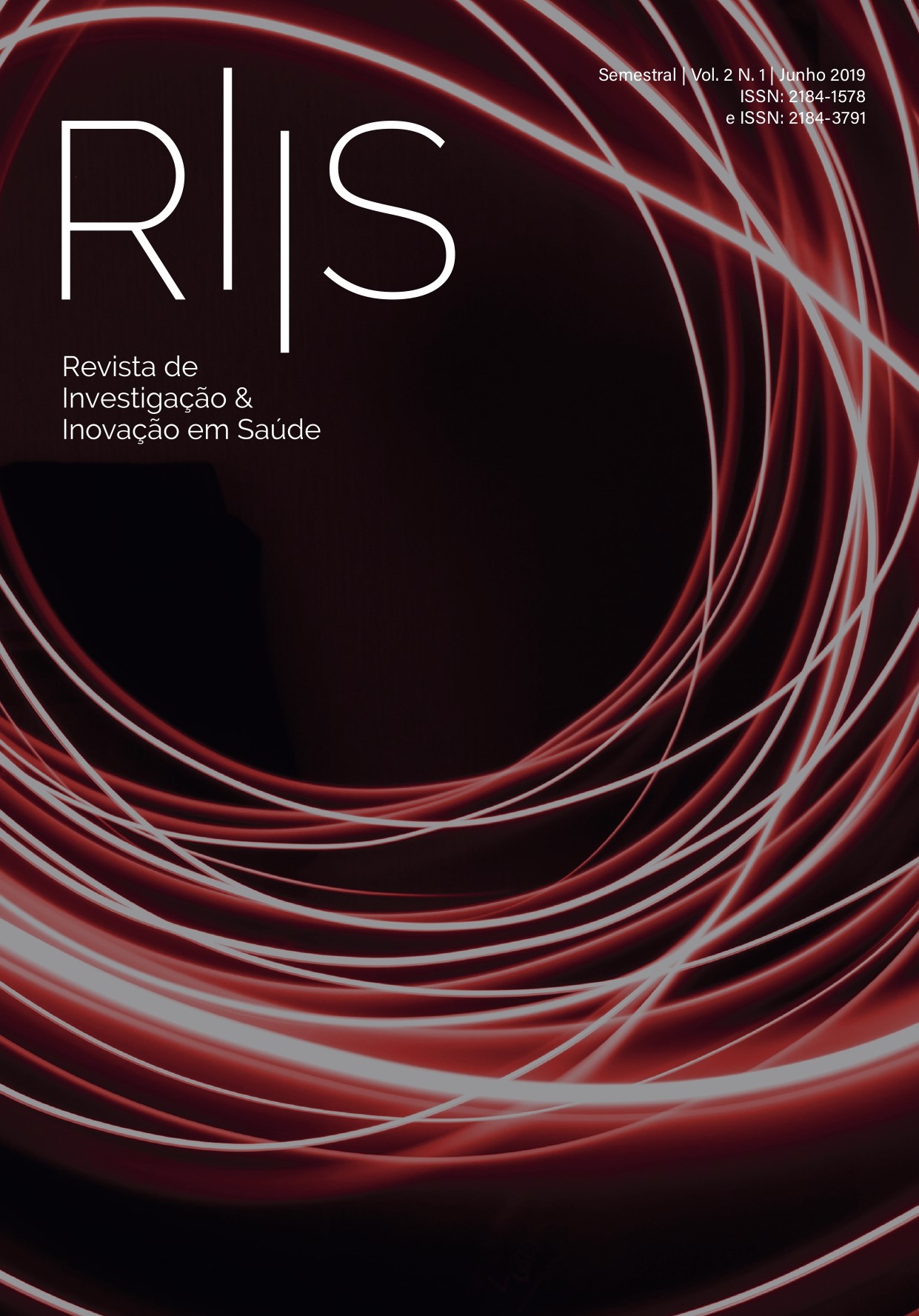Prevalence of work-related musculoskeletal disorders in nurses: integrative review
DOI:
https://doi.org/10.37914/riis.v2i1.48Keywords:
nurses; musculoskeletal disorders; prevalenceAbstract
Framework: nursing practice is related to activities that require constant and misaligned musculoskeletal solicitation as a consequence of the imbalance between the professional / equipment/patient, leading professionals to adopt incorrect and harmful postures to their own health. Objective: to know the prevalence of work-related musculoskeletal injuries (WRMSD) in nurses. Methodology: an integrative review was conducted with a search in Medline, SciELO and CINHAL databases, with the descriptors "nurses", "musculoskeletal diseases" and "prevalence", combined with the Boolean operator "AND", from prevalence studies published between 2012 and 2017. Of the 174 studies identified, 24 were included for review. Results: there is a high prevalence of WRMSD, ranging from 25 to 98%, especially lumbar spine injury. Conclusion: WRMSD has a negative impact on nurses' personal, professional and social life. Research in this area should be directed to the interpretation of causal factors and implementation of preventive / corrective measures and institutions’ capacitation for the importance of preventive, behavioural and ergonomic measures.
References
Alperovitch-Najenson, D., Sheffer, D., Treger, I., Finkels, T., & Kalichman, L. (2014). Rehabilitation versus Nursing Home Nurses' Low Back and Neck-Shoulder Complaints. Rehabilitation Nursing, 40(5), 286-93. https://doi: 10.1002/rnj.172
Arvidsson, I., Simonsen, J. G., Dahlqvist, C., Axmon, A., Karlson, B., Björk, J., Nordander, C. (2016). Cross-sectional associations between occupational factors and musculoskeletal pain in women teachers, nurses and sonographers. BMC Musculoskeletal Disorders, 17, 35. https://doi: 10.1186/s12891-016-0883-4
Arvidsson, I., Simonsen, J. G., Balogh, I., Hansson, G., Dahlqvist, C., Granqvist, L. ... Nordander, C. (2012). Discrepancies in pain presentation caused by adverse psychosocial conditions as compared to pain due to high physical workload?. Work, 41, 2472-2475. https://doi: 10.3233/WOR-2012-0483-2472
Attar, S. M. (2014). Frequency and risk factors of musculoskeletal pain in nurses at a tertiary centre in Jeddah, Saudi Arabia: a cross sectional study. BMC Research Notes, 7, 61. https://doi: 10.1186/1756-0500-7-61
Barzideh, M., Choobineh, A. R., & Tabatabaee, H. R. (2014). Job stress dimensions and their relationship to musculoskeletal disorders in Iranian nurses. Work, 47(4), 423-9. https://doi: 10.3233/WOR-121585
Briggs, J. (2017). Checklist for Prevalence Studies. The Joanna Briggs Institute. Retirado de: http://joannabriggs.org/research/critical-appraisal-tools.html
Coggon, D., Ntani, G., Palmer, KT., Felli, VE., Harari, R., Barrero, LH. ... Gray, A. (2013). Disabling musculoskeletal pain in working populations: is it the job, the person, or the culture? Pain, 154(6), 856-63. https://doi: 10.1016/j.pain.2013.02.008
Davis, K. G., & Kotowsky, S. E. (2015). Prevalence of Musculoskeletal Disorders for Nurses in Hospitals, Long-Term Care Facilities, and Home Health Care: A Comprehensive Review. The Journal of the Human Factors and Ergonomics Society, 57(5), 754-92. https://doi: 10.1177/0018720815581933
Fernandes, C. N., Couto, G., Carvalho, R., Fernandes, D. G., Brito, L., Carvalho, P., & Ferreira, P. F. (2018). "Risk observation in the handling of dependent patients in health professionals of a hospital unit". Nursing Practice Today 5 (4), 385-394. http://dx.doi.org/10.18502/npt.v5i4.117
Fouts B. L., Serres J. L., Dukes S. F., Maupin G. M., Wade M. E., & Pohlman D. M. (2015). Investigation of Self-Reported Musculoskeletal Injuries on Post-Deployment Health Assessment Forms for Aeromedical Evacuation Personnel. Military Medicine, 180(12), 1256-61. https://doi: 10.7205/MILMED-D-14-00606
Freimann, T., Pääsuke, M., & Merisalu, E. (2016). Work-Related Psychosocial Factors and Mental Health Problems Associated with Musculoskeletal Pain in Nurses: A Cross - Sectional Study. Pain Research and Management, 2016, 1-7. https://doi: 10.1155/2016/9361016
Freimann, T., Coggon, D., Merisalu, E., Animägi, L., & Pääsuke, M. (2013). Risk factors for musculoskeletal pain amongst nurses in Estonia: a cross-sectional study. BMC Musculoskeletal Disorders, 14, 334. https://doi: 10.1186/1471-2474-14-334
Galvão, T., & Pereira, M. (2014). Revisões sistemáticas da literatura: passos para a sua elaboração. Epidemiologia e Serviços de Saúde, 23 (1), 183-184. https://doi: 10.5123/S1679-49742014000100018
Harcombe H., Herbison, G. P., McBride, D., & Derrett, S. (2014). Musculoskeletal disorders among nurses compared with two other occupational groups. Occupational Medicine, 64(8), 601-7. https://doi: 10.1093/occmed/kqu117
Hoof, WV., O’Sullivan, K., O’Keeffe, M., Verschueren, S., O’Sullivan, P., & Dankaerts, W. (2018). The efficacy of interventions for low back pain in nurses: A systematic review. International Journal of Nursing Studies, 77, 222-231. https://doi: 10.1016/j.ijnurstu.2017.10.015
Jerónimo, J., & Cruz, A. (2014) - Estudo da prevalência e fatores de risco de lesões músculo-esqueléticas ligadas ao trabalho em enfermeiros. Revista de investigação em Enfermagem, 9, 35-46. retirado de: http://www.sinaisvitais.pt/images/stories/Rie/Rie9_Serie2.pdf
Lelis, C., Battaus, M., Freitas, F., Rocha, F., Marziale, M., & Robazzi, M. (2012). Distúrbios osteomusculares relacionados ao trabalho em profissionais de enfermagem: revisão integrativa da literatura. Acta Paulista de Enfermagem, 25 (3), 477-482. https://doi: 10.1590/S0103-21002012000300025
Long, M., Bogossian, F., & Johnston, V. (2013). The prevalence of work-related neck, shoulder and upper back musculoskeletal disorders among midwives, nurses, and physicians. A systematic review. Workplace Health & Safety, 61(5), 223-229. https://doi: 10.1177/216507991306100506
Long, M. H., Johnston, V., & Bogossian, F. E. (2013). Helping women but hurting ourselves? Neck and upper back musculoskeletal symptoms in a cohort of Australian Midwives. Midwifery, 29(4), 359-67. https://doi: 10.1016/j.midw.2012.02.003
Machado, L. S., Rodrigues, E. P., Oliveira, L. M., Laudano R. C., & Sobrinho, C. L. (2014). Health problems reported by nursing workers in a public hospital of Bahia. Revista Brasileira de Enfermagem, 67 (5), 684-91.
Moher, D., Shamseer, L., Clarke, M., Ghersi, D., Liberati, A., Petticrew, M., … Group, P.-P. (2015). Preferred Reporting Items for Systematic Review and Meta-Analysis Protocols (PRISMA-P) 2015 statement. Systematic Reviews, 4, 9. https://doi: 10.1186/2046-4053-4-1
Moreira, R. F., Sato, T. O., Foltran, F. A., Silva, L. C., & Coury, H. J. (2014). Prevalence of musculoskeletal symptoms in hospital nurse technicians and licensed practical nurses: associations with demographic factors. Brazilian Journal of Physical Therapy, 18(4), 323–333. https://doi: 10.1590/bjpt-rbf.2014.0026
Munabi, I. G., Buwembo, W., Kitara, D. L., Ochieng, J., Nabirye, R. C., & Mwaka, E. S. (2014). Musculoskeletal disorders among nursing staff: a comparison of five hospitals in Uganda. The Pan African Medical Journal, 17, 81-8. https://doi: 10.11604/pamj.2014.17.81.3213
Nasiri-Ziba, F., Nosrati, S., Hanani, S. (2016). The prevalence of musculoskeletal disorders among undergraduates and technicians of operating room of the educational hospitals affiliated with Iran University of Medical Sciences in 2016. Nursing Practice Today, 4(3), 134-142. Retirado de: http://npt.tums.ac.ir/index.php/npt/article/view/251
Ranney, D. (2000). Distúrbios osteomusculares Crónicos Relacionados ao Trabalho. São Paulo: Editora Roca.
Reed, L. F., Battistutta, D., Young, J., & Newman, B. (2014). Prevalence and risk factors for foot and ankle musculoskeletal disorders experienced by nurses. BMC Musculoskeletal Disorders, 15, 196. https://doi: 10.1186/1471-2474-15-196
Serralheira, F., & Uva, A. (2007). Identificação e avaliação do risco de LMEMSLT. Livro de Atas da Conferência Internacional SHO 2007. Sociedade Portuguesa de Segurança e Higiene Ocupacionais: Guimarães. ISBN: 978-972-99504-3-8
Serralheira, F., Cotrim, T., Rodrigues, V., Nunes, C., & Uva, A. (2012). Lesões músculo-esqueléticas Ligadas ao trabalho em enfermeiros portugueses: «ossos do ofício» ou doenças relacionadas com o trabalho. Revista Portuguesa de Saúde Pública, 30 (2), 193-203. retirado de: http://www.scielo.mec.pt/pdf/rpsp/v30n2/v30n2a10.pdf
Shieh, S. H., Sung, F. C., Su,C. H., Tsai, Y., & Hsieh, V. C. (2016). Increased low back pain risk in nurses with high workload for patient care: A questionnaire survey. Taiwanese Journal of Obstetrics and Gynecology, 55(4), 525-9. https://doi: 10.1016/j.tjog
Simonsen, J. G., Arvidsson, I. & ,Nordander, C. (2012). Ergonomics in the operating room. Work, 41 (Suppl 1), 5644-6. https://doi: 10.3233/WOR-2012-0905-5644
Souza, M., Silva, M., & Carvalho, R. (2010). Revisão integrativa: o que é e como fazer. Einstein, 8 102-108. http://dx.doi.org/10.1590/s1679-45082010rw1134
Wang, S. Y., Liu, L. C., Lu, M. C., & Koo, M. (2015). Comparisons of musculoskeletal disorders among ten different medical professions in Taiwan: a nationwide, population-based study. PLoS One, 10(4), e0123750. https://doi: 10.1371/journal.pone.0123750















